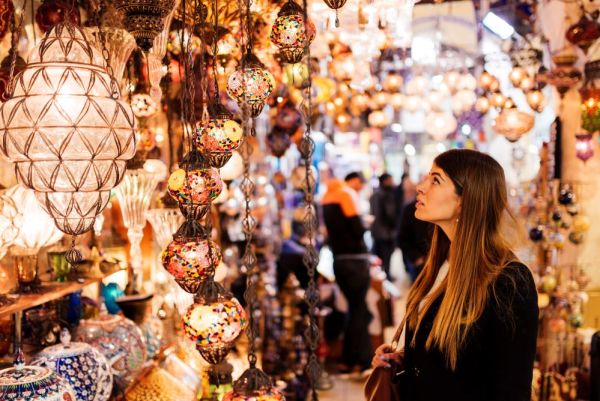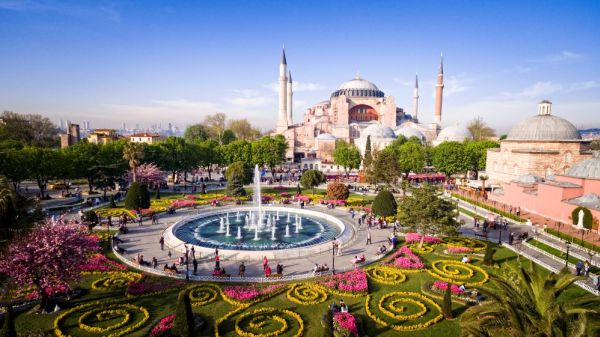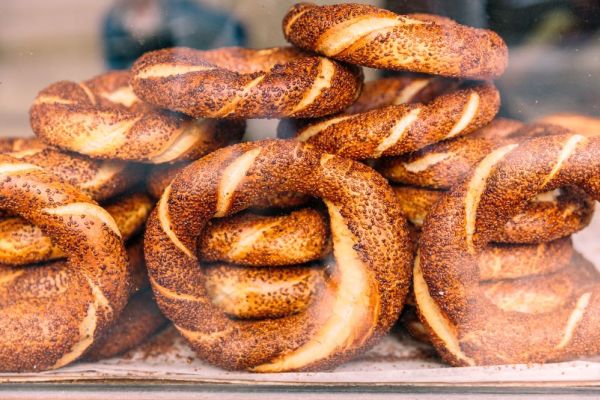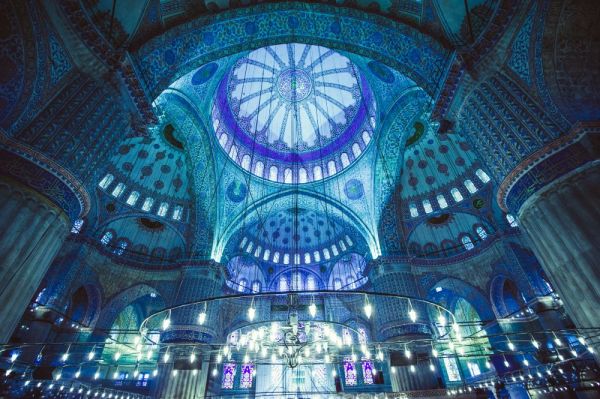IstanbulTravel Guide
Istanbul is Turkey’s biggest and possibly most intriguing city. With a “foot” in two continents — Europe and Asia — it offers an exciting mix of ancient history, rich culture and modern city life that draws tourists from all over the world.
Istanbul was once the capital of three great empires — Roman, Byzantine and Ottoman — so if you’re a history fan, you’ll be in your element “time-travelling” through the millennia. Today, old and new exist side by side, with one of the world's oldest markets, the Grand Bazaar, contrasting with avant-garde galleries and upmarket rooftop bars.
Where else can you start off with a traditional Turkish breakfast, then head off to explore Byzantine palaces, cruise down the Bosphorus Strait between Europe and Asia, and later enjoy fine dining followed by clubbing in a hipster neighbourhood?
The epitome of a cultural melting pot, Istanbul’s cuisine, art, music and traditions reflect Mediterranean, Middle Eastern and Balkan influences. Add to this a sensory overload of sights, sounds and colours, and an unforgettable visit is guaranteed!
So, whether you're a cultural, culinary or experiential traveller, come and experience the thrill of one of world's most unique cities.
Explore Istanbul
Where to stay in Istanbul?
There are two sides of Istanbul — 25 districts on the European side and 14 on the Asian side. The sides are connected by three major suspension bridges across the Bosphorus Strait, a waterway that connects the Back Sea to the Sea of Marmara. Each side, district and neighbourhood has its own distinct style and a wide selection of B&Bs, luxury hotels, guesthouses, boutique hotels and hotel chains.
The “port-side” Karaköy neighbourhood in the Beyoğlu district is all about trendy bars, eclectic restaurants and exciting nightlife. If this is your scene, SuB Karaköy stands out from typical luxury hotels. It’s industrial yet chic, offering well-appointed rooms with décor inspired by the harbour and sea. Here you can enjoy all the amenities of a luxury hotel (and the famous Turkish breakfast) with the bonus of being in the middle of the action.
Taksim Square is a tourist hotspot and this part of Istanbul offers many entertainment, retail and dining options, as well as accommodation to suit every pocket. The cheery, cosy Cheers Midtown Hostel offers nine rooms and is close to the tram line. It's the perfect place to lay your head after an all-nighter!
Also, consider staying on the Asian side, which is generally more affordable than the European side. For example, the residential neighbourhood of Kadiköy (not to be confused with Karaköy on the European side) is popular with the young and trendy. Here, you can find low-key, comfy accommodation such as the Juliet Rooms and Kitchen, which has both deluxe rooms and hostel dormitory rooms.
The historic Sultanahmet neighbourhood is the area to stay in if you’re visiting for a short time and want to see as many tourist attractions as possible. Offering an unusual stay, Hotel Poem memorialises famous artists, writers and composers connected to the city, from Pyotr Tchaikovsky to Ernest Hemmingway. The rooms are spacious with views over the Bosphorus Strait, and the hotel is ideally situated near the Hagia Sophia Grand Mosque, the Blue Mosque and Topkapi Palace attractions.
When it comes to exceptional service and jaw-dropping views, it’s hard to beat Hotel Amira in the Fatih district and the Georges Hotel Galata. Hotel Amira has a wide range of room options for couples and families, as well as the standout Amiralto Rooftop Restaurant and Bar where you can indulge in award-winning dining and admire the city lights reflected in the Sea of Marmara.
Georges Hotel Galata in the Galata quarter of the Beyoğlu district takes things up a notch by offering personalised butler services, modern sophistication with a touch of French class and several awards to its name.
Believe us when we say, this is just the start. Book your Istanbul accommodation today!
Things to do in Istanbul
The districts in Istanbul are packed with attractions and activities — way too many to list here, so we’ve selected some standouts worthy of every traveller’s must-do/see list.
See the city from all sides by cruising down the Bosphorus Straight. Throw in dinner and a show and you have the makings of a magical experience.
Istanbul is known for many grand palaces dotted across both sides of the city. See how the other half lived in the opulent Beylerbeyi Palace in the neighbourhood of Üsküdar on the Asian side. Meander through the landscaped gardens and admire the grandeur of a bygone era of Ottoman sultans. On the European side, the magnificent Topkapi Palace is among the most famous stately landmarks and one of the largest museum-palaces in the world. It houses collections of Turkish treasures, such as ornate ceramics, art, jewellery and weaponry.
Forget dark and pokey buildings smelling musty and dusty — Istanbul’s museums are next level! From the charming Istanbul Toy Museum (Kadiköy district), the delicious Pelit Chocolate Museum (Esenyurt district) and the fascinating Archaeological Museum (Fatih district) to the Innocence Museum (Beyoğlu district) showcasing the culture and history of Istanbul, you’re seriously spoilt for choice.
The Hagia Sophia Grand Mosque, built in 537 AD, is among the city’s most mesmerising historical buildings and the oldest cathedral in the world. Set on a hill in Fatih on the European side, its mind-boggling architecture features domes, spiking towers (minarets), Byzantine mosaics and 104 columns. Take a tour with a headset on and find out all about the mosque’s fascinating history.
The spectacular Blue Mosque is opposite the Hagia Sophia on the other side of Sultanahmet Square. It wasn’t built to compete with the grand mosque but rather to complement it — and it certainly does with its own charms, immense size and six minarets.
On the Asian side, the historic landmark of the Maiden’s Tower stands all alone on an islet in the Bosphorus Strait. Shrouded in legend and mystery (about a maiden, yes) and many other tales, you can get to it by boat from Üsküdar.
To experience a modern architectural wonder built in 1992, take an afternoon stroll across the famous Galata Bridge that connects the Galata and Karaköy neighbourhoods on the European side of Istanbul over the Golden Horn inlet. You’ll encounter people from all walks of life, including fisherman casting their lines.
The tradition of bathhouses is woven into several cultures, including that of the Turks. Indulging in a Turkish bath or hammam (steam bath) is a unique experience and highly recommended when you visit Istanbul. Basically, it involves a hot room like a sauna, a full-body exfoliation, a foam massage and a rinse — so no actual bathwater! For an upscale experience, head to the magnificent Kılıç Ali Paşa Hamam in Beyoğlu on the European side. For a low-key and totally traditional take, there’s Cinili Hamam on the Asian side in Üsküdar.
Looking for an immersive experience? Then an Istanbul tour is the way to go.
Flights to Istanbul
Istanbul food and drink
Istanbul’s cuisine evolved over centuries, shaped by its diverse cultures, rich history and unique location. Greek, Armenian and Jewish influences stand out the most. The city's numerous foodie hotspots and restaurants cater to every palate and budget, offering everything from fine dining and experimental fusion foods to traditional fare and street food.
In the Sultanahmet neighbourhood, traditional Turkish restaurants are scattered throughout the backstreets of the Blue Mosque. This is where you’ll find delicious meze platters (bite-sized hot and cold dishes) on the menu. Ordering one of these is the best way to get acquainted with the local fare. The locals flock to Tarihi Sultanahmet Köftecisi Selim Usta, so you know the food is good.
For a unique experience, head to the historical Flower Arcade (Çiçek Pasaji) in the Beyoğlu district. Built in the late 1800s, the beautiful interior is a feast for the eyes! It’s lined with meyhanes (Turkish restaurant-bars), European beer halls and a variety of restaurants.
To experience the Asian side of Turkish cuisine, head to the vibey district of Kadiköy. Look for lahmacun on the menu — a popular street food that consists of Turkish flatbread topped with minced meat, spices, tomatoes and herbs. Often called the Turkish pizza, some like it spicy, some like it garlicky, but everyone agrees it’s delicious! Halil Lahmacun has years of experience making this dish and with some of the best recipes and bases, it’s a popular lunch spot. Join the queue, it’s worth it.
To experience authentic street food culture, head to the Asian side of Istanbul where each neighbourhood has its own special dishes. In Kadiköy, look for the borek stands selling baked or fried pastries (borek) filled with cheese, minced meat, spinach or potatoes, and the kumpir stands selling stuffed baked potatoes. The historic district of Üsküdar is known for stuffed mussels (midye dolma) and lahmacun, and Çengelköy for sesame bread rings called simit. Another neighbourhood with a buzzing street food scene is Moda. Try the fish sandwiches (balik ekmek) or, if you’re brave, the delicacy of kokoreç (grilled lamb intestines).
For something special, dine at Turk Fatih Tutak in Şişli on the European side, which boasts two Michelin stars. Award-winning Chef Fatif sources ingredients from local and artisanal producers and creates a constantly changing, experimental menu paired with delicious Turkish wine.
Over in Kanlica on the Asian side, dining at the stunning A'jia Restaurant will make you feel like a celeb. Think chandeliers and rose petals on your seat! Set in a five-star boutique hotel on the Bosphorus Strait, this award-winning eatery offers an eclectic menu with French, Italian and local flair.
By the way, if you spot the word “ikram” on the bill in traditional or fine-dining restaurants in Istanbul, don’t panic about the coffee and tea you will be offered every few minutes, as it’s on the house!
Get a real taste for the local cuisine by booking an Istanbul tour.
Where to shop in Istanbul?
There is nothing quite like shopping in Istanbul. Many cities around the world have souks, medinas, bazaars and markets, but Istanbul has that wow factor because, as we’ve mentioned before, it’s home to one of the largest and oldest covered markets in the world. So, arrive with your haggling skills and keep extra space in your bags!
The Grand Bazaar is the most famous of all shopping experiences in Istanbul. Found in the Fatih district of the European side, this bazaar has been thriving as a trading hot spot for centuries. Some say there are 3,000 shops, some say closer to 4,000. Whichever it is, the 550-year-old living museum with its labyrinth of over 60 covered streets is a bucket-list shopping adventure. Picture carpets, textiles, brightly coloured lanterns, antiques, delicately painted vases, trinkets and jewellery all waiting to be haggled for.
Did you know Istanbul was one of the central points of the Spice Route as various goods made their way from Egypt to China and back? Next to the Grand Bazaar, the Spice Bazaar or Egyptian Bazaar is a go-to if you have a sweet tooth or are looking for culinary delights. Here, stalls are packed high with mountains of dates, Turkish delight, fragrant spices, nuts and teas. A feast for the senses!
Istanbul also has a host of smaller bazaars in different neighbourhoods, each with their own unique selling points and characteristics. Arasta Bazaar in the Fatih district has a charming, laid-back vibe. It’s around the corner from the Blue Mosque and above the Great Palace Mosaic Museum, so you can enjoy several cultural aspects of Istanbul and top it off by buying a handmade Turkish carpet (kilim) to take home.
The Kadiköy market on Asian side is also highly recommended. There are Tuesday and Friday markets where the locals come to do their shopping and tuck into Turkish food. Expect a low-key fun experience and bargains on clothing, homeware and fresh produce.
If you’re more of a mall rat than a bargain hunter, you’ll be pleased to know the city has over 200 modern European-style malls where you can find many international brands. The Mall of Istanbul in the Başakşehir district is a mega mall with loads of stores and even an indoor theme park, while Istinye Park in the Sariyer district is for the high-end fashionistas.
On the Asian side in Üsküdar, the upscale Akasya mall houses over 200 stores and a cinema. The Tepe Nautilus mall in Kadiköy is a fun, maritime-themed mall offering everything from clothing, accessories and perfume to kiddies’ shops and entertainment.
Looking for a safe and simple way to bring your money when you travel? Our Travel Money Card has you covered!
When is the best time to travel to Istanbul?
Istanbul has a Mediterranean climate where the summers (July–August) are warm and humid with highs averaging around 26°C to 27°C (78.8°F to 80.6°F).
The winters are long, cold and wet with the average lows around 5°C to 6°C (41°F to 42.8°F) in January and occasional snow. There’s also plenty of rain year-round, most of which falls between October and December. The climate across Istanbul is relatively the same but the Asian side can be slightly warmer — especially in summer, as it’s more inland.
Autumn and spring, from March to May and from September to October, are good seasons for visiting as warm, sunny days are plentiful with temperatures between 24°C and 29°C (75.2°F and 84.2°F).
Peak season is in summer when loads of tourists descend on the city. Check the European holiday dates when booking your trip, as you might find yourself queuing a lot, particularly at the main attractions. Off-season is from November to March with the quietest period being December to February, when it’s cold and wet.
Don't miss out. Book your Istanbul flight today!
How to get around Istanbul
Istanbul has a comprehensive public transport network, including ferries, trams (on the European side), metro trains, buses, funiculars, shared taxis (called dolmuş) and cable cars.
The Istanbulkart smart card can be used on nearly all forms of public transport within the city, and you can recharge it at various locations, such as service stations and kiosks. Enjoy a nostalgic tram ride between Taksim Square and Tünel Square for something a little different.
Note that the Istanbulkart can’t be used for dolmuş taxis, so you'll need to pay cash. These minibuses follow set routes, but you can hop on and off. While dolmuş stations are scattered throughout the city, you can also flag them down on the street.
Uber is also available in Istanbul. While it offers convenience and peace of mind, your Uber will likely be a dolmuş taxi and you’ll have to pay an additional surcharge.
Ferries operate between the European side and Asian side of the city between the famous north and south of the Golden Horn. They also travel to the Princes’ Islands, the Bosphorus Strait and the Black Sea.
Exploring the city on a rental bike can be loads of fun but if you’re not feeling particularly fit, you can hire an e-bike from tour operators, bike shops and sometimes from hotels.
Let us help you organise your own wheels for exploring. Hire a car in Istanbul today!
What are the best beaches in Istanbul?
Istanbul has beaches on both the European and Asian sides ranging from urban public beaches to private beach clubs. You can also enjoy island beaches during your stay! Let’s look a bit closer at the options.
Florya Güneş Beach is a sand-and-pebble beach close to the city on the Sea of Marmara. It’s popular with families due to its calm waters and nearby aquarium and park. There are also cafés and restaurants along the promenade.
The Kilyos area on the Black Sea coast features several golden-sand beaches offering water sports and lively beach-club scenes, such as the picturesque Uzunya Beach surrounded by mountains.
The Princes' Islands (or Adalar) is the name given to an archipelago of nine islands in the Sea of Marmara. The four main islands — Büyükada, Heybeliada, Burgazada and Kınalıada — are open to tourists and can be reached by ferry from the European and Asian sides. They offer a tranquil escape from the city and are uncommercialised, unspoilt and car-free. Adding to their charm is the mode of transport: horse-drawn carriages! The islands have both rocky and sandy beaches, as well as some upscale beach clubs.
Caddebostan Beach in the Kadiköy district is a small family-friendly beach with a long stretch of sand dotted with sun loungers. It’s part of the Caddebostan-Dalyan Park, which offers a mix of outdoor recreation, shopping, dining and nightlife.
The nearby Kiziltoprak Beach is known for its vibey atmosphere. It offers some basic amenities like ablution fountains, and food and drink vendors. Plus, it’s easily accessible by public transport.








